compartment FORD TRANSIT 2020 Owners Manual
[x] Cancel search | Manufacturer: FORD, Model Year: 2020, Model line: TRANSIT, Model: FORD TRANSIT 2020Pages: 529, PDF Size: 8.3 MB
Page 6 of 529
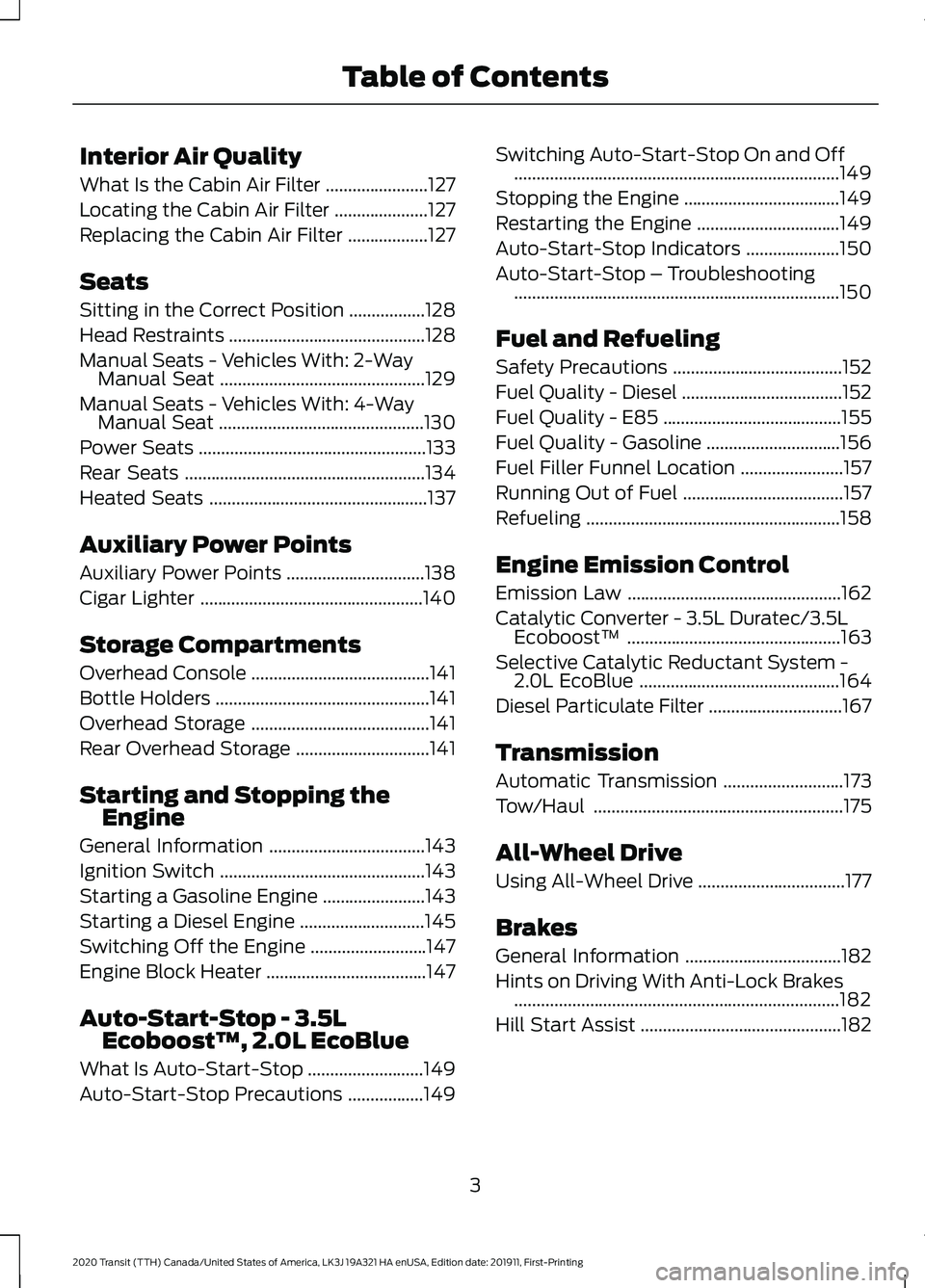
Interior Air Quality
What Is the Cabin Air Filter
.......................127
Locating the Cabin Air Filter .....................
127
Replacing the Cabin Air Filter ..................
127
Seats
Sitting in the Correct Position .................
128
Head Restraints ............................................
128
Manual Seats - Vehicles With: 2-Way Manual Seat ..............................................
129
Manual Seats - Vehicles With: 4-Way Manual Seat ..............................................
130
Power Seats ...................................................
133
Rear Seats ......................................................
134
Heated Seats .................................................
137
Auxiliary Power Points
Auxiliary Power Points ...............................
138
Cigar Lighter ..................................................
140
Storage Compartments
Overhead Console ........................................
141
Bottle Holders ................................................
141
Overhead Storage ........................................
141
Rear Overhead Storage ..............................
141
Starting and Stopping the Engine
General Information ...................................
143
Ignition Switch ..............................................
143
Starting a Gasoline Engine .......................
143
Starting a Diesel Engine ............................
145
Switching Off the Engine ..........................
147
Engine Block Heater ....................................
147
Auto-Start-Stop - 3.5L Ecoboost™, 2.0L EcoBlue
What Is Auto-Start-Stop ..........................
149
Auto-Start-Stop Precautions .................
149Switching Auto-Start-Stop On and Off
........................................................................\
.
149
Stopping the Engine ...................................
149
Restarting the Engine ................................
149
Auto-Start-Stop Indicators .....................
150
Auto-Start-Stop – Troubleshooting ........................................................................\
.
150
Fuel and Refueling
Safety Precautions ......................................
152
Fuel Quality - Diesel ....................................
152
Fuel Quality - E85 ........................................
155
Fuel Quality - Gasoline ..............................
156
Fuel Filler Funnel Location .......................
157
Running Out of Fuel ....................................
157
Refueling .........................................................
158
Engine Emission Control
Emission Law ................................................
162
Catalytic Converter - 3.5L Duratec/3.5L Ecoboost™ ................................................
163
Selective Catalytic Reductant System - 2.0L EcoBlue .............................................
164
Diesel Particulate Filter ..............................
167
Transmission
Automatic Transmission ...........................
173
Tow/Haul ........................................................
175
All-Wheel Drive
Using All-Wheel Drive .................................
177
Brakes
General Information ...................................
182
Hints on Driving With Anti-Lock Brakes ........................................................................\
.
182
Hill Start Assist .............................................
182
3
2020 Transit (TTH) Canada/United States of America, LK3J 19A321 HA enUSA, Edition date: 201911, First-Printing Table of Contents
Page 13 of 529
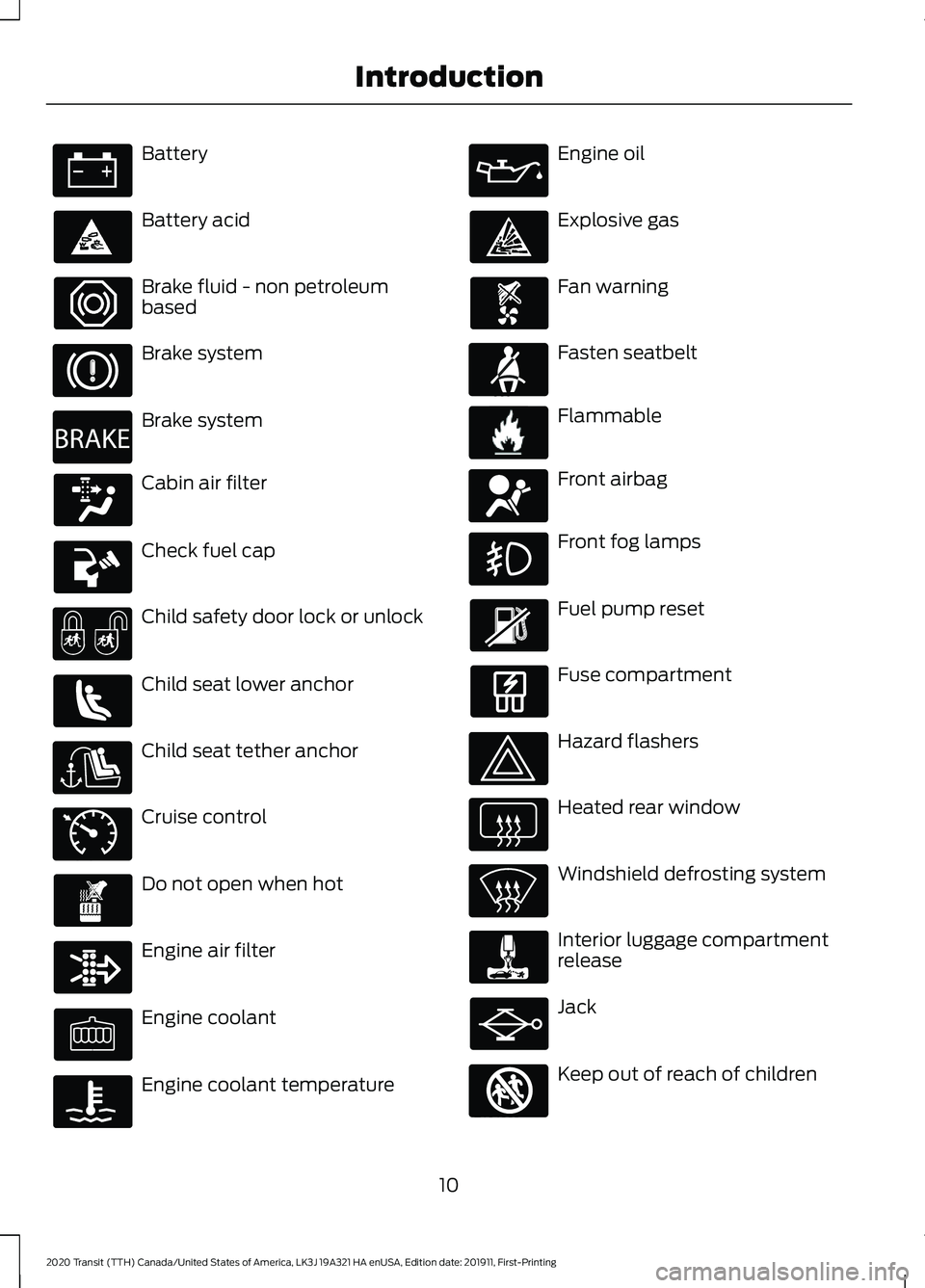
Battery
Battery acid
Brake fluid - non petroleum
based
Brake system
Brake system
Cabin air filter
Check fuel cap
Child safety door lock or unlock
Child seat lower anchor
Child seat tether anchor
Cruise control
Do not open when hot
Engine air filter
Engine coolant
Engine coolant temperature Engine oil
Explosive gas
Fan warning
Fasten seatbelt
Flammable
Front airbag
Front fog lamps
Fuel pump reset
Fuse compartment
Hazard flashers
Heated rear window
Windshield defrosting system
Interior luggage compartment
release
Jack
Keep out of reach of children
10
2020 Transit (TTH) Canada/United States of America, LK3J 19A321 HA enUSA, Edition date: 201911, First-Printing Introduction E270480 E71340 E71880 E231160 E67017 E161353
Page 71 of 529
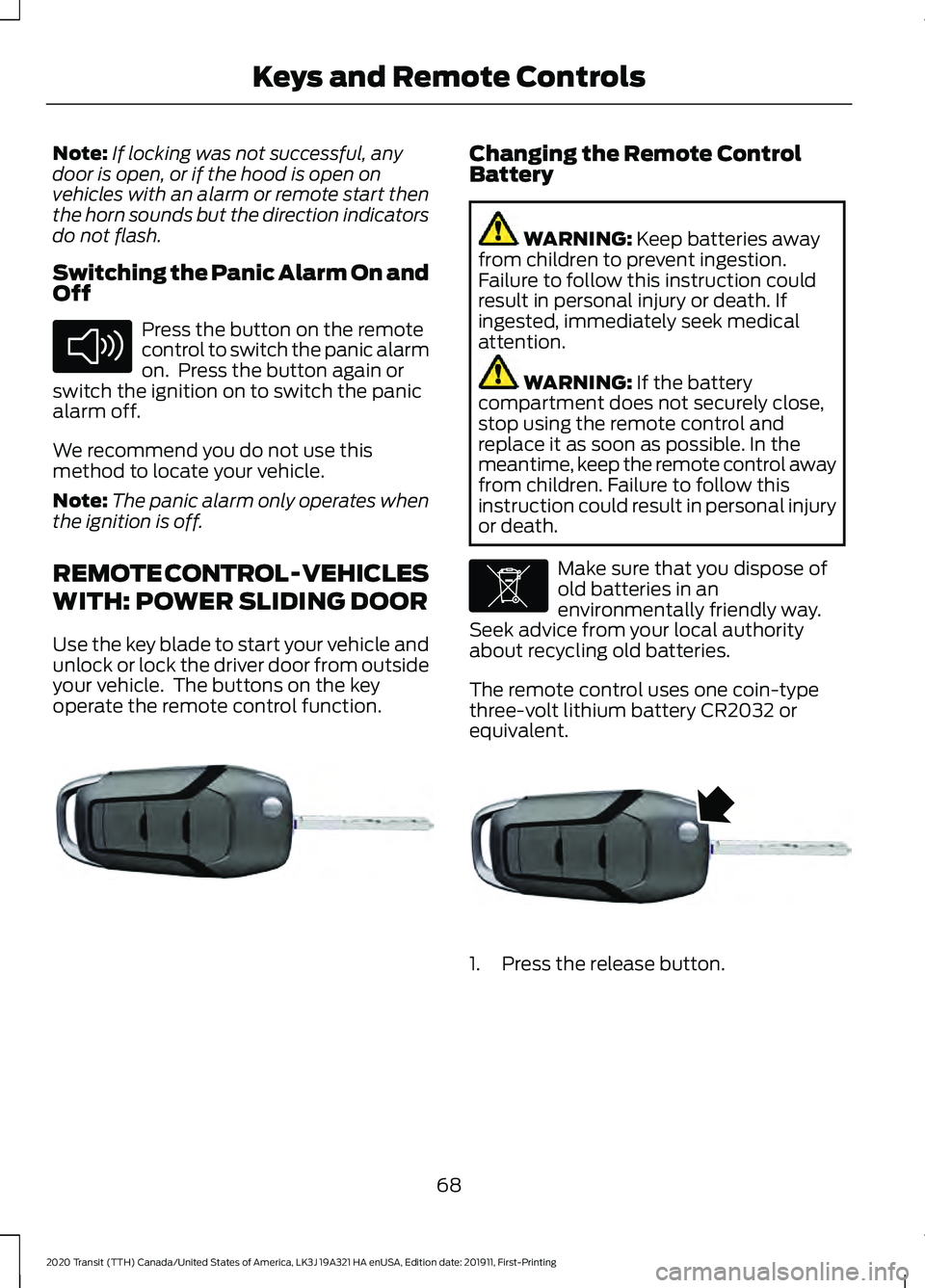
Note:
If locking was not successful, any
door is open, or if the hood is open on
vehicles with an alarm or remote start then
the horn sounds but the direction indicators
do not flash.
Switching the Panic Alarm On and
Off Press the button on the remote
control to switch the panic alarm
on. Press the button again or
switch the ignition on to switch the panic
alarm off.
We recommend you do not use this
method to locate your vehicle.
Note: The panic alarm only operates when
the ignition is off.
REMOTE CONTROL - VEHICLES
WITH: POWER SLIDING DOOR
Use the key blade to start your vehicle and
unlock or lock the driver door from outside
your vehicle. The buttons on the key
operate the remote control function. Changing the Remote Control
Battery
WARNING: Keep batteries away
from children to prevent ingestion.
Failure to follow this instruction could
result in personal injury or death. If
ingested, immediately seek medical
attention. WARNING:
If the battery
compartment does not securely close,
stop using the remote control and
replace it as soon as possible. In the
meantime, keep the remote control away
from children. Failure to follow this
instruction could result in personal injury
or death. Make sure that you dispose of
old batteries in an
environmentally friendly way.
Seek advice from your local authority
about recycling old batteries.
The remote control uses one coin-type
three-volt lithium battery CR2032 or
equivalent. 1. Press the release button.
68
2020 Transit (TTH) Canada/United States of America, LK3J 19A321 HA enUSA, Edition date: 201911, First-Printing Keys and Remote ControlsE138624 E302820 E107998 E302821
Page 94 of 529

2.
Switch the ignition from off to on. Keep
the ignition on for at least three
seconds, but no more than 10 seconds.
3. Switch the ignition off and remove the
first correctly coded key from the
ignition.
4. After three seconds but within 10 seconds of switching the ignition off,
insert the second previously correctly
coded key into the ignition.
5. Switch the ignition from off to on. Keep
the ignition on for at least three
seconds, but no more than 10 seconds.
6. Switch the ignition off and remove the
second previously programmed
correctly coded key from the ignition.
7. After three seconds but within 10 seconds of switching the ignition off
and removing the previously
programmed correctly coded key,
insert the new unprogrammed key into
the ignition.
8. Switch the ignition from off to on. Keep
the ignition on for at least six seconds.
9. Remove the newly programmed correctly coded key from the ignition.
If the key has been successfully
programmed it will start the engine and
operate the remote entry system (if the
new key is an integrated keyhead
transmitter).
If the key was not successfully
programmed, wait 10 seconds and repeat
Steps 1 through 8. If you are still
unsuccessful, take your vehicle to an
authorized dealer.
Note: You can program a maximum of eight
coded keys to your vehicle. All eight can be
integrated keyhead transmitters. ANTI-THEFT ALARM -
VEHICLES WITHOUT: ANTI-
THEFT ALARM HORN WITH
INTEGRAL BATTERY
Alarm System
The perimeter alarm is a deterrent against
unauthorized access to your vehicle
through the doors, luggage compartment
and the hood.
Triggering the Alarm
Once armed, the alarm is triggered in any
of the following ways:
•
If someone opens a door, cargo area
or the hood without a valid key or
remote control.
• If you switch the ignition on without a
valid key.
If the alarm is triggered, the horn will sound
for 30 seconds and the hazard warning
flasher will flash for five minutes.
Any further attempts to perform one of the
above will trigger the alarm again.
Arming the Alarm
To arm the alarm, lock your vehicle. See
Doors and Locks (page 77).
Disarming the Alarm
Disarm and silence the alarm by unlocking
the doors with the key and switching the
ignition on with a correctly coded key
within 12 seconds, or by unlocking the
doors or the cargo area with the remote
control.
91
2020 Transit (TTH) Canada/United States of America, LK3J 19A321 HA enUSA, Edition date: 201911, First-Printing Security
Page 124 of 529
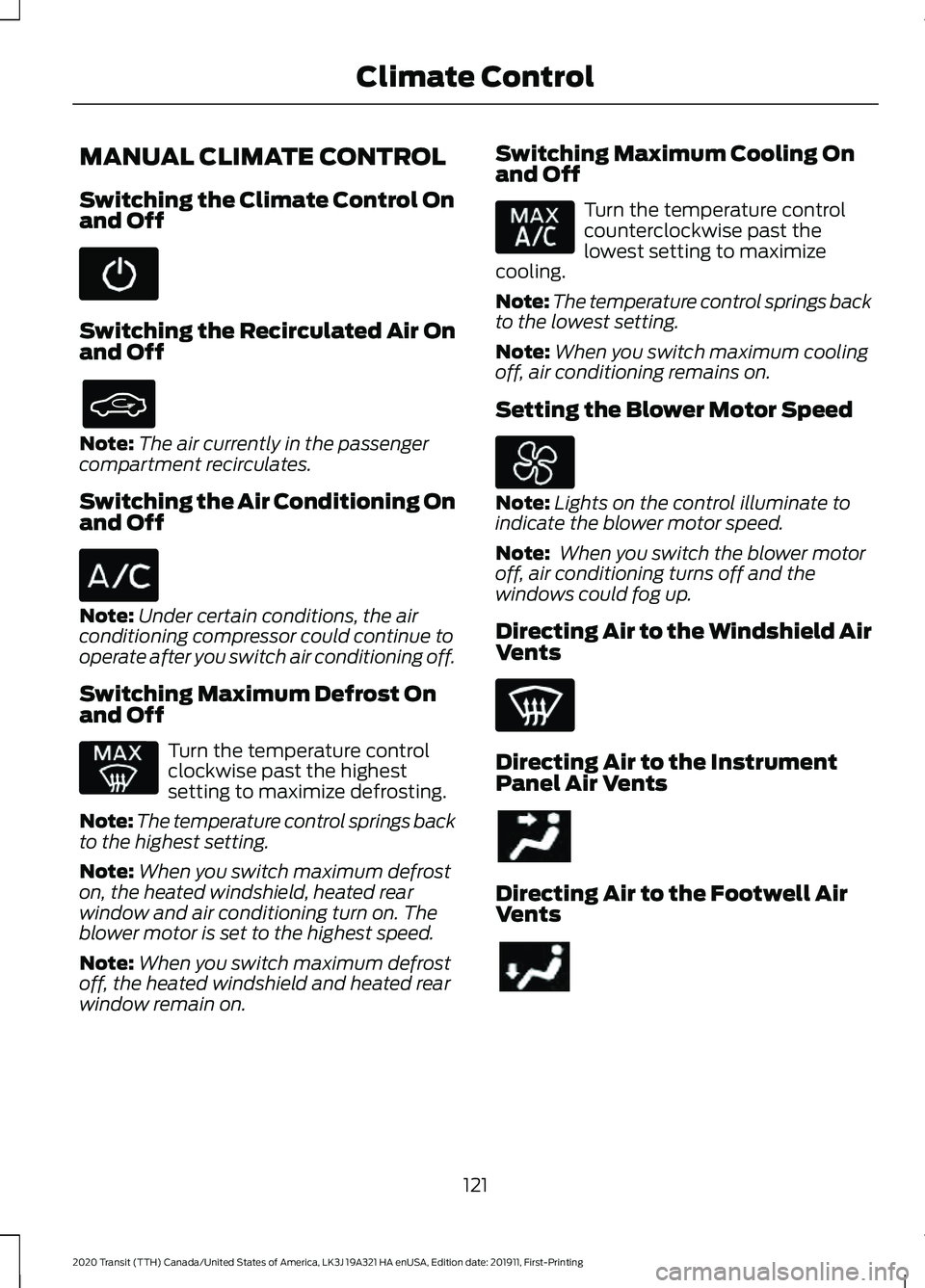
MANUAL CLIMATE CONTROL
Switching the Climate Control On
and Off
Switching the Recirculated Air On
and Off
Note:
The air currently in the passenger
compartment recirculates.
Switching the Air Conditioning On
and Off Note:
Under certain conditions, the air
conditioning compressor could continue to
operate after you switch air conditioning off.
Switching Maximum Defrost On
and Off Turn the temperature control
clockwise past the highest
setting to maximize defrosting.
Note: The temperature control springs back
to the highest setting.
Note: When you switch maximum defrost
on, the heated windshield, heated rear
window and air conditioning turn on. The
blower motor is set to the highest speed.
Note: When you switch maximum defrost
off, the heated windshield and heated rear
window remain on. Switching Maximum Cooling On
and Off Turn the temperature control
counterclockwise past the
lowest setting to maximize
cooling.
Note: The temperature control springs back
to the lowest setting.
Note: When you switch maximum cooling
off, air conditioning remains on.
Setting the Blower Motor Speed Note:
Lights on the control illuminate to
indicate the blower motor speed.
Note: When you switch the blower motor
off, air conditioning turns off and the
windows could fog up.
Directing Air to the Windshield Air
Vents Directing Air to the Instrument
Panel Air Vents
Directing Air to the Footwell Air
Vents
121
2020 Transit (TTH) Canada/United States of America, LK3J 19A321 HA enUSA, Edition date: 201911, First-Printing Climate Control
Page 127 of 529
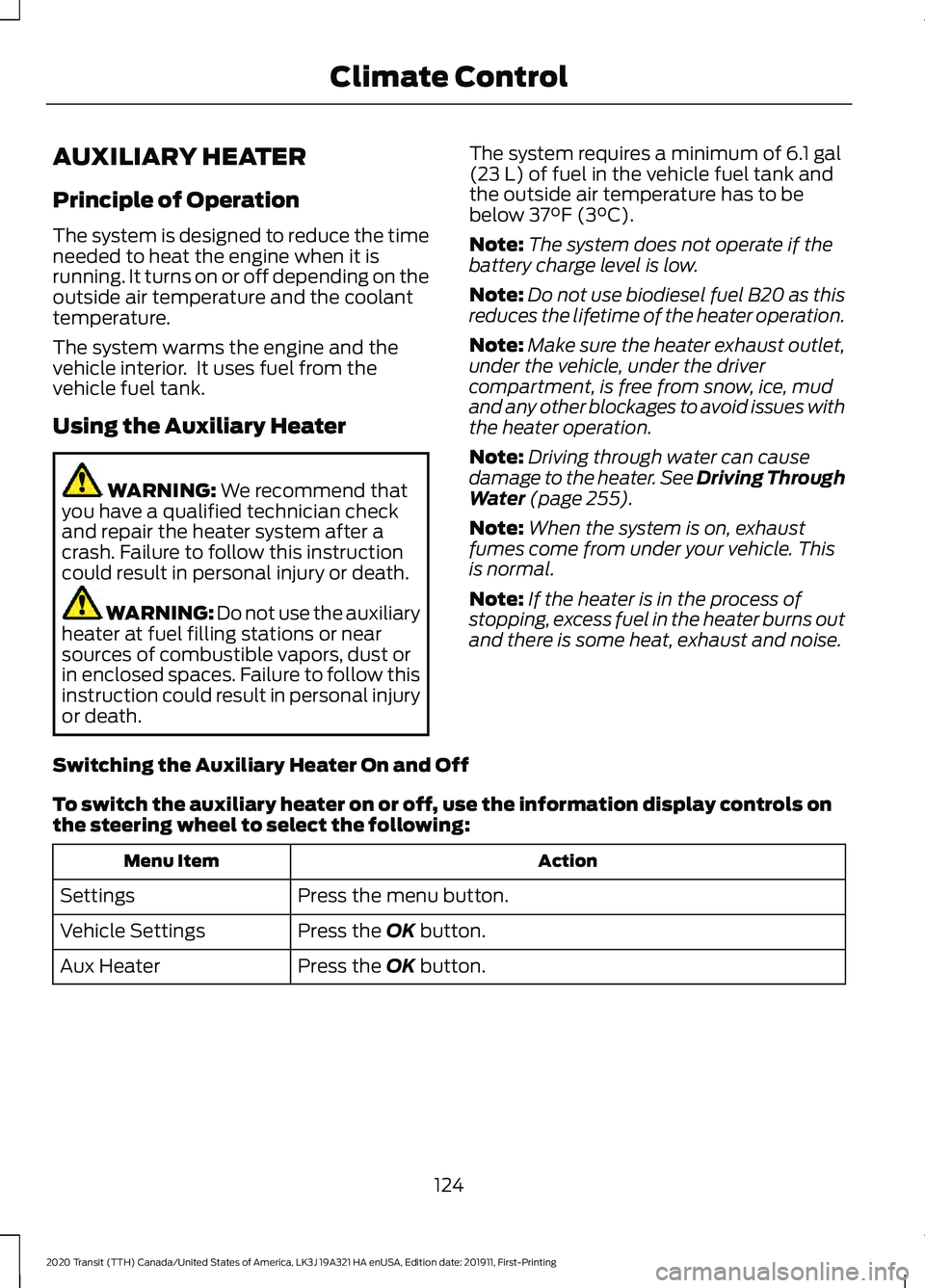
AUXILIARY HEATER
Principle of Operation
The system is designed to reduce the time
needed to heat the engine when it is
running. It turns on or off depending on the
outside air temperature and the coolant
temperature.
The system warms the engine and the
vehicle interior. It uses fuel from the
vehicle fuel tank.
Using the Auxiliary Heater
WARNING: We recommend that
you have a qualified technician check
and repair the heater system after a
crash. Failure to follow this instruction
could result in personal injury or death. WARNING: Do not use the auxiliary
heater at fuel filling stations or near
sources of combustible vapors, dust or
in enclosed spaces. Failure to follow this
instruction could result in personal injury
or death. The system requires a minimum of
6.1 gal
(23 L) of fuel in the vehicle fuel tank and
the outside air temperature has to be
below
37°F (3°C).
Note: The system does not operate if the
battery charge level is low.
Note: Do not use biodiesel fuel B20 as this
reduces the lifetime of the heater operation.
Note: Make sure the heater exhaust outlet,
under the vehicle, under the driver
compartment, is free from snow, ice, mud
and any other blockages to avoid issues with
the heater operation.
Note: Driving through water can cause
damage to the heater. See Driving Through
Water
(page 255).
Note: When the system is on, exhaust
fumes come from under your vehicle. This
is normal.
Note: If the heater is in the process of
stopping, excess fuel in the heater burns out
and there is some heat, exhaust and noise.
Switching the Auxiliary Heater On and Off
To switch the auxiliary heater on or off, use the information display controls on
the steering wheel to select the following: Action
Menu Item
Press the menu button.
Settings
Press the
OK button.
Vehicle Settings
Press the
OK button.
Aux Heater
124
2020 Transit (TTH) Canada/United States of America, LK3J 19A321 HA enUSA, Edition date: 201911, First-Printing Climate Control
Page 130 of 529
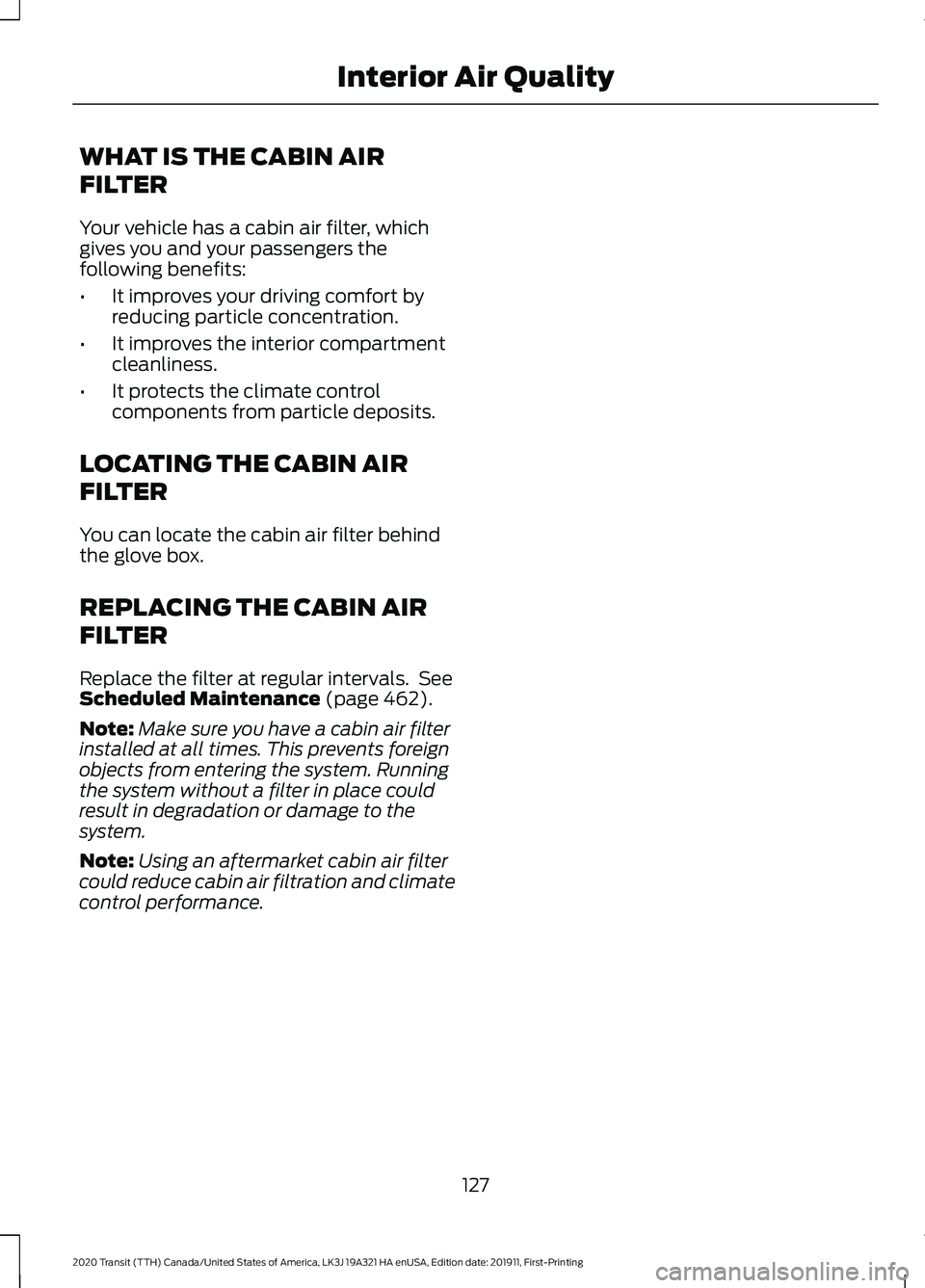
WHAT IS THE CABIN AIR
FILTER
Your vehicle has a cabin air filter, which
gives you and your passengers the
following benefits:
•
It improves your driving comfort by
reducing particle concentration.
• It improves the interior compartment
cleanliness.
• It protects the climate control
components from particle deposits.
LOCATING THE CABIN AIR
FILTER
You can locate the cabin air filter behind
the glove box.
REPLACING THE CABIN AIR
FILTER
Replace the filter at regular intervals. See
Scheduled Maintenance (page 462).
Note: Make sure you have a cabin air filter
installed at all times. This prevents foreign
objects from entering the system. Running
the system without a filter in place could
result in degradation or damage to the
system.
Note: Using an aftermarket cabin air filter
could reduce cabin air filtration and climate
control performance.
127
2020 Transit (TTH) Canada/United States of America, LK3J 19A321 HA enUSA, Edition date: 201911, First-Printing Interior Air Quality
Page 141 of 529
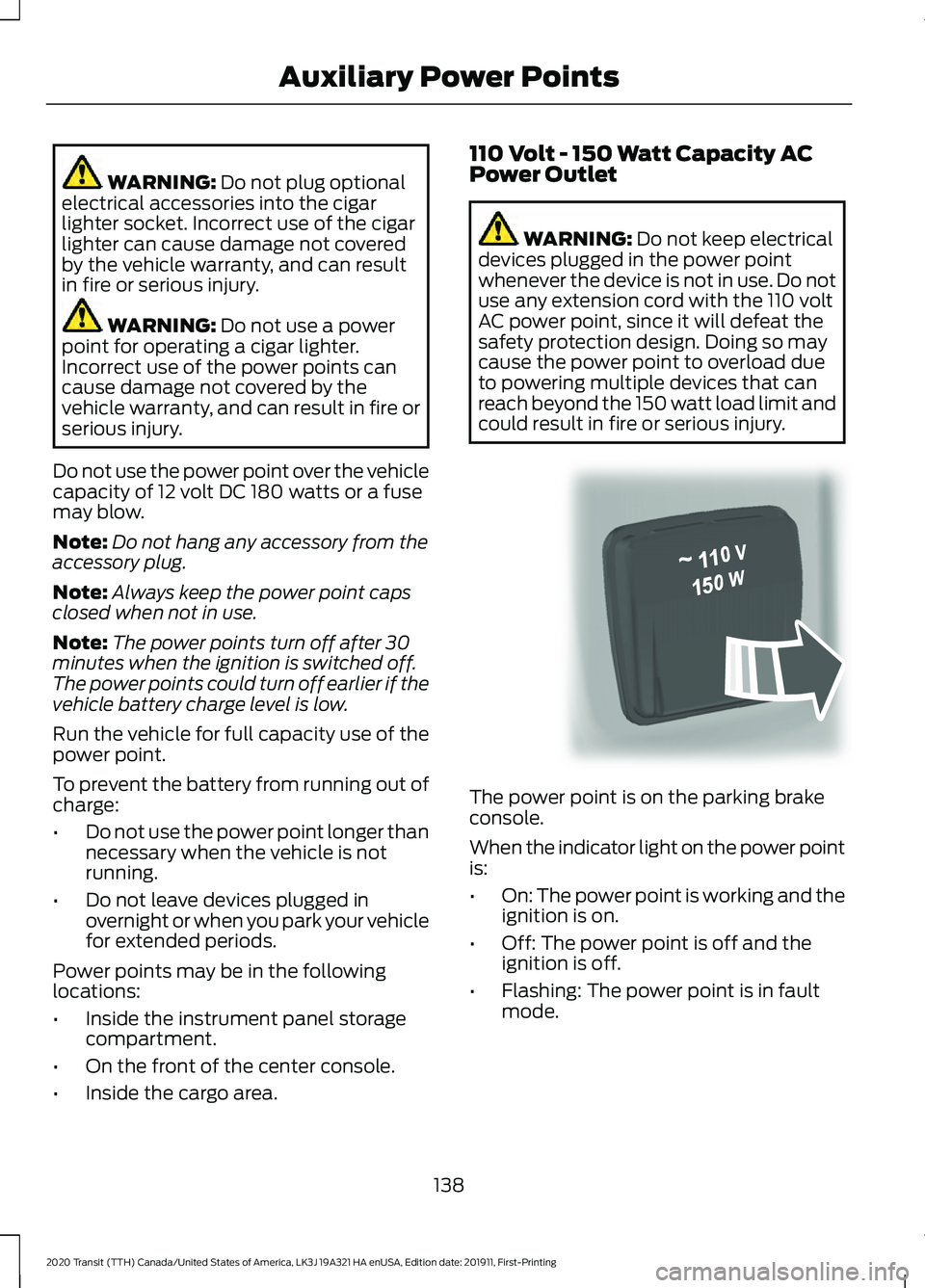
WARNING: Do not plug optional
electrical accessories into the cigar
lighter socket. Incorrect use of the cigar
lighter can cause damage not covered
by the vehicle warranty, and can result
in fire or serious injury. WARNING:
Do not use a power
point for operating a cigar lighter.
Incorrect use of the power points can
cause damage not covered by the
vehicle warranty, and can result in fire or
serious injury.
Do not use the power point over the vehicle
capacity of 12 volt DC 180 watts or a fuse
may blow.
Note: Do not hang any accessory from the
accessory plug.
Note: Always keep the power point caps
closed when not in use.
Note: The power points turn off after 30
minutes when the ignition is switched off.
The power points could turn off earlier if the
vehicle battery charge level is low.
Run the vehicle for full capacity use of the
power point.
To prevent the battery from running out of
charge:
• Do not use the power point longer than
necessary when the vehicle is not
running.
• Do not leave devices plugged in
overnight or when you park your vehicle
for extended periods.
Power points may be in the following
locations:
• Inside the instrument panel storage
compartment.
• On the front of the center console.
• Inside the cargo area. 110 Volt - 150 Watt Capacity AC
Power Outlet WARNING:
Do not keep electrical
devices plugged in the power point
whenever the device is not in use. Do not
use any extension cord with the 110 volt
AC power point, since it will defeat the
safety protection design. Doing so may
cause the power point to overload due
to powering multiple devices that can
reach beyond the 150 watt load limit and
could result in fire or serious injury. The power point is on the parking brake
console.
When the indicator light on the power point
is:
•
On: The power point is working and the
ignition is on.
• Off: The power point is off and the
ignition is off.
• Flashing: The power point is in fault
mode.
138
2020 Transit (TTH) Canada/United States of America, LK3J 19A321 HA enUSA, Edition date: 201911, First-Printing Auxiliary Power PointsE305821
Page 144 of 529
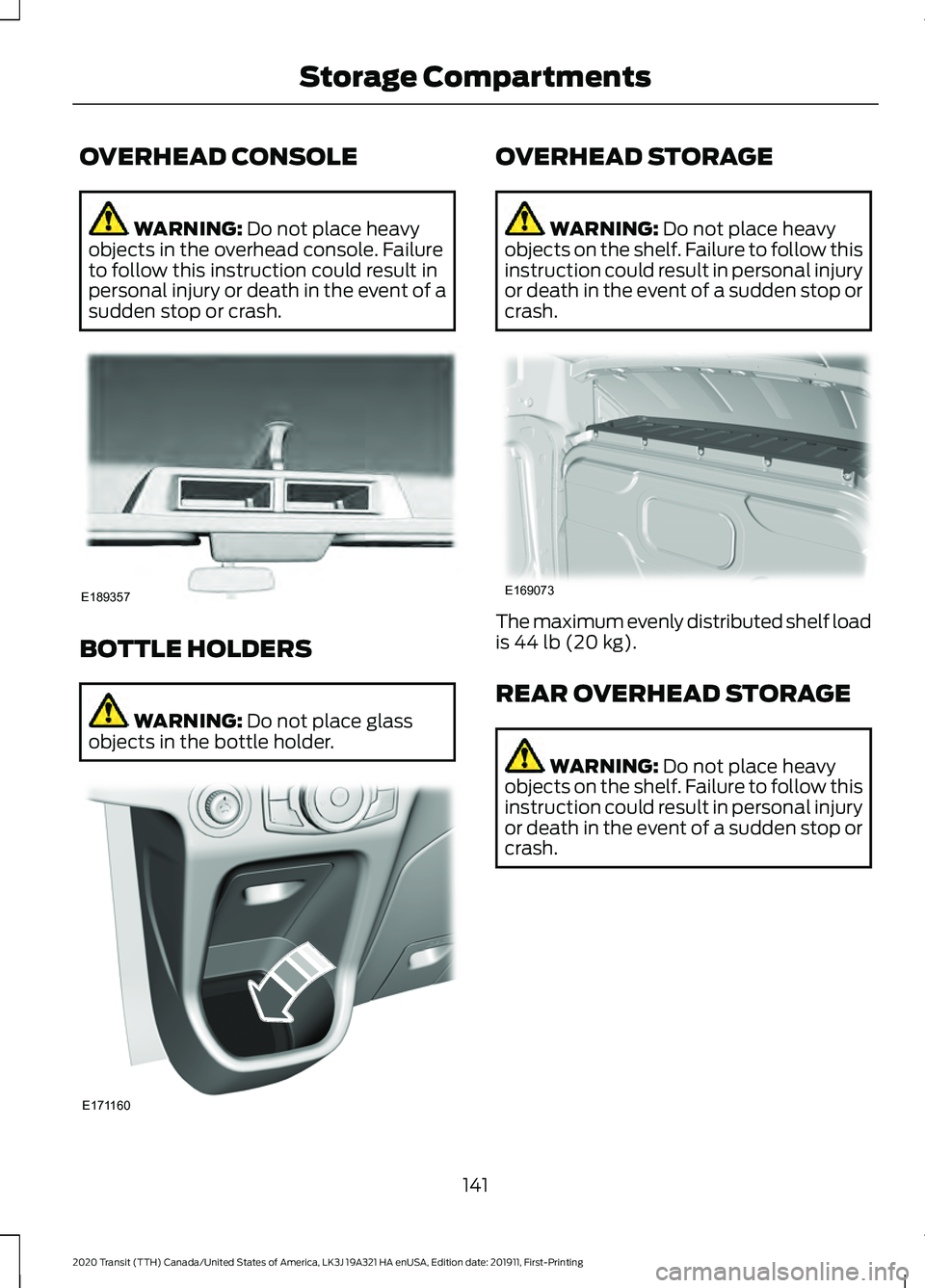
OVERHEAD CONSOLE
WARNING: Do not place heavy
objects in the overhead console. Failure
to follow this instruction could result in
personal injury or death in the event of a
sudden stop or crash. BOTTLE HOLDERS
WARNING:
Do not place glass
objects in the bottle holder. OVERHEAD STORAGE
WARNING:
Do not place heavy
objects on the shelf. Failure to follow this
instruction could result in personal injury
or death in the event of a sudden stop or
crash. The maximum evenly distributed shelf load
is
44 lb (20 kg).
REAR OVERHEAD STORAGE WARNING:
Do not place heavy
objects on the shelf. Failure to follow this
instruction could result in personal injury
or death in the event of a sudden stop or
crash.
141
2020 Transit (TTH) Canada/United States of America, LK3J 19A321 HA enUSA, Edition date: 201911, First-Printing Storage CompartmentsE189357 E171160 E169073
Page 145 of 529
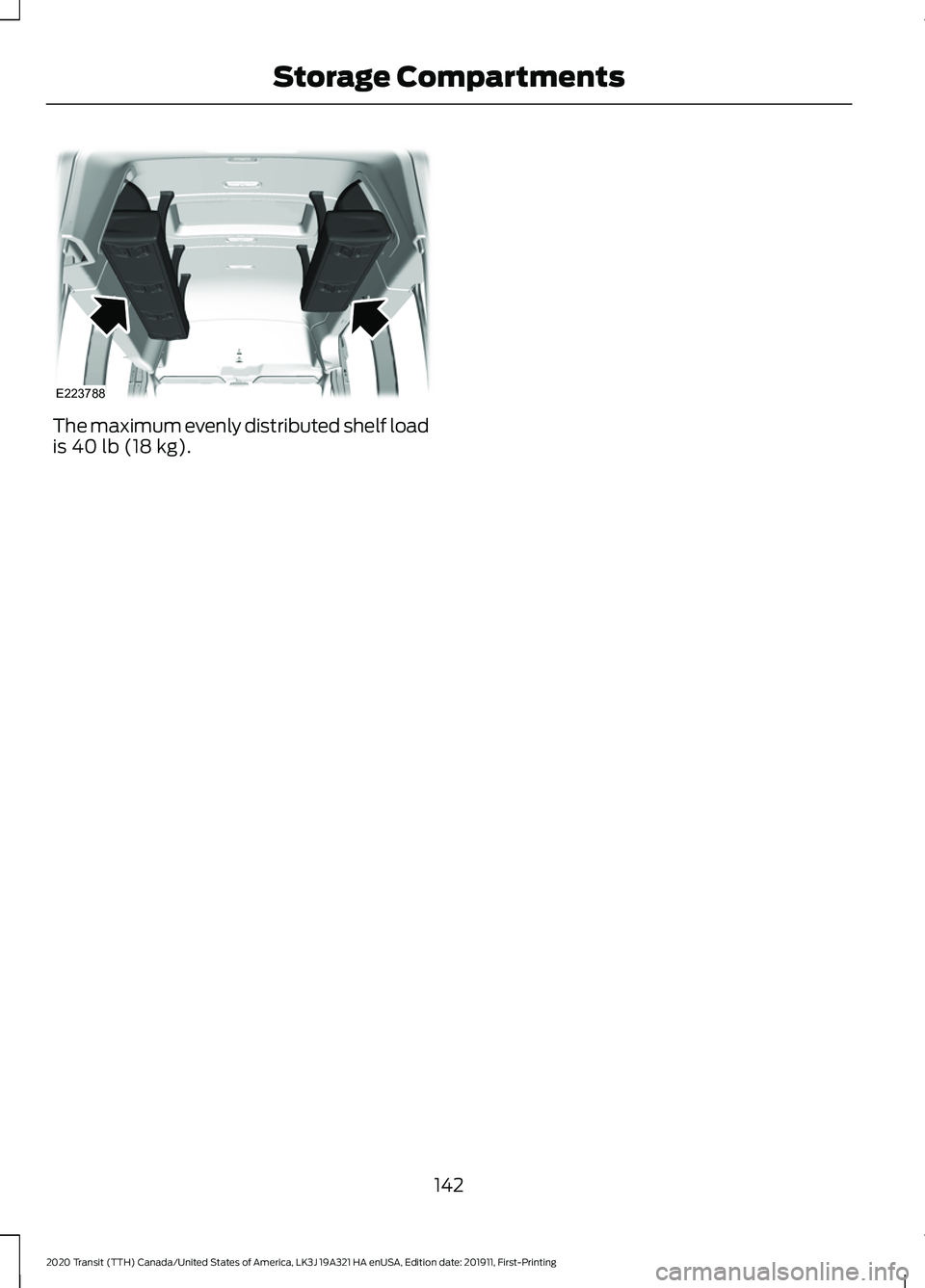
The maximum evenly distributed shelf load
is 40 lb (18 kg).
142
2020 Transit (TTH) Canada/United States of America, LK3J 19A321 HA enUSA, Edition date: 201911, First-Printing Storage CompartmentsE223788